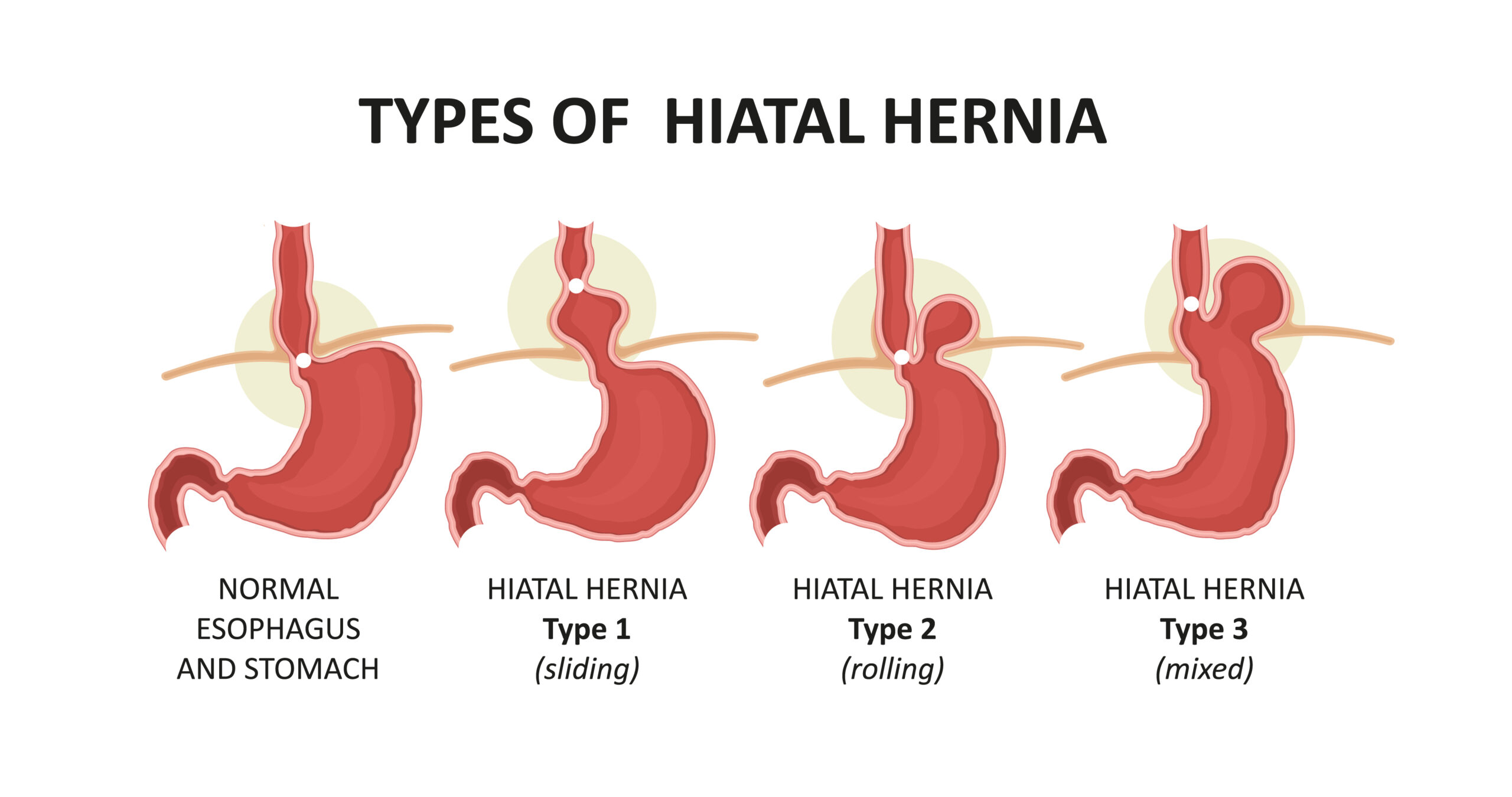Hiatal hernia is when part of the stomach, and in the most severe cases, even the entire stomach, is located in the chest. Your chest is separated from your abdomen by the diaphragm (a muscle that ventilates your lungs).
The diaphragm has openings through which large blood vessels and the esophagus pass. In a healthy person, the esophagus passes through the esophageal hiatus into the abdominal cavity, connecting to the stomach. Sometimes, the stomach may move into the chest cavity, called a hiatal hernia.
Several factors contribute to the formation of a hiatal hernia. One is the increased pressure in the abdomen, which presses the diaphragm and pushes the stomach into the chest through the diaphragm hole. Therefore, risk factors for esophageal hernia are obesity and heavy lifting.
The cause of a hiatal hernia is also a weakening of the diaphragm muscles. This can occur as a result of trauma, after surgery, and also as a result of a stroke. Weakness of the diaphragm can also affect older and debilitated people. An enlarged esophageal hiatus and a displaced stomach can also be congenital abnormalities.
In some cases, no clear cause can be identified.
There are three types of hiatal hernia: sliding, para-esophageal (rolling), and mixed.
This is the most common type of hiatal hernia, accounting for about 90% of all cases. In this type, the initial part of the stomach (cardia) slides into the chest through the hole in the diaphragm, the muscle that separates the chest from the abdomen.
As a result, the lower esophageal sphincter muscle is weakening. When it works correctly, this muscle prevents the stomach contents from flowing back into the esophagus.
The indications of this disorder are similar to those of gastroesophageal reflux disease. A patient with a sliding hernia has heartburn, regurgitates food, has trouble swallowing, and experiences chest pain. In addition, there can also be difficulty breathing, irregular heartbeats, and discomfort in the upper belly area. The timbre of the voice may also change slightly due to the accompanying hoarseness and recurrent cough. Not all patients have the same symptoms.
This type of hernia is usually tiny and can slide back and forth, making symptoms disappear and revert.

A rolling hernia![]() is also called a para-esophageal hernia. In this type of hernia, the connection between the esophagus and the stomach remains under the diaphragm, while the upper part protrudes into the chest.
is also called a para-esophageal hernia. In this type of hernia, the connection between the esophagus and the stomach remains under the diaphragm, while the upper part protrudes into the chest.
This type of hernia often does not cause any symptoms. If left untreated, a rolling hernia causes bleeding in the stomach lining. It also causes similar symptoms as a sliding hernia. Shortness of breath may occur if a significant portion of the stomach is displaced into the chest.
To diagnose this type of hernia, gastroscopy (examination of the upper digestive tract, including the esophagus, stomach, and duodenum) is used.
This type of hernia has features of both sliding and rolling hernias.
A hiatal hernia![]() may be asymptomatic and detected by chance during examination for other medical conditions. However, most commonly, the disease manifests itself by:
may be asymptomatic and detected by chance during examination for other medical conditions. However, most commonly, the disease manifests itself by:
It is characteristic that the symptoms worsen after heavy meals and when lying down. The symptoms often resemble other ailments, including coronary artery disease.
The symptom most commonly experienced by people with hiatal hernia is heartburn![]() .
.
The lower esophageal sphincter muscle relaxes when the junction between the esophagus and the stomach is moved into the chest cavity. This muscle properly functions as a one-sided valve that allows food from the esophagus to enter the stomach but prevents its backflow.
When the muscle fails, the stomach acid backs up into the esophagus. As a result, it causes irritation and, thus, inflammation of the mucous membrane of the esophagus. Then, a burning sensation is felt around the heart and behind the breastbone.

Yes, a hiatal hernia can sometimes feel like a heart attack. In most cases, it doesn’t involve heart problems, but because of the proximity of the hernia and the heart and the pain intensity it may cause, it might mimic a heart attack. Chest pain should always be noted, and heart disease should be ruled out before confirming that it is a hernial pain.
Sometimes, in rare cases of hiatal hernia, when a whole stomach is displaced into the chest, it can lead to cardiac arrest![]() .
.
Hiatal hernia is more common in older people and women. The following also contribute to its formation:

Tests that allow the doctor to make a diagnosis![]() of a hiatal hernia include:
of a hiatal hernia include:
The method of treatment depends on the stage of the disease.
The most commonly used drug treatment is proton pump inhibitors![]() , i.e., drugs that reduce gastric acid secretion. They are usually used on an empty stomach once a day, in the morning. Other medicines used in the treatment are H2 blockers. However, medicine therapy does not treat the hernia but alleviates its symptoms. An equally important treatment element is using a proper diet, such as those recommended for gastroesophageal reflux disease.
, i.e., drugs that reduce gastric acid secretion. They are usually used on an empty stomach once a day, in the morning. Other medicines used in the treatment are H2 blockers. However, medicine therapy does not treat the hernia but alleviates its symptoms. An equally important treatment element is using a proper diet, such as those recommended for gastroesophageal reflux disease.
When medical treatment is insufficient, the doctor may perform a surgical procedure. Another indication for surgery is gastric displacement, especially when it is massive. In this case, the most often performed treatment method is Nissen fundoplication![]() .
.
This surgery has two different types:
Both types of operation are performed under general anesthesia. The advantage of the Nissen surgery is a significant reduction of the symptoms of the disease. The patient also stops feeling pain in the chest, the burning sensation in the esophagus becomes less, and the unpleasant smell from the mouth disappears.
Like any operation, Nissen fundoplication requires proper preparation. You should perform the tests ordered by the doctor and be on an empty stomach on the day of the procedure.
As with any surgical procedure, laparoscopic Nissen fundoplication carries some, though small, risk of complications. The most important of them is the occurrence of bleeding, infection of the surgical wound, and the formation of an abscess. Mortality associated with this type of procedure is low and mainly affects people with other serious diseases.
There are several ways to prevent the symptoms of a hiatal hernia. Every person with a disease should use them as an addition to pharmacological treatment. Lifestyle modifications![]() primarily involve diet. A diet similar to that for reflux disease is recommended.
primarily involve diet. A diet similar to that for reflux disease is recommended.
You should limit the consumption of:
You can eat most vegetables, fruits, lean dairy products, and meat.
Experts also recommend tips on how to take food. Eat several small portions, with the last meal 2-3 hours before bedtime. Resting in a lying position and exercising immediately after eating is inadvisable. Certain herbal remedies, including chamomile, might additionally assist in lessening the intensity of symptoms.
The patient should sleep with the pillow raised a few inches and limit head bending, especially after meals. Quitting smoking is also recommended.
Inflammation of the esophagus![]() can occur if a hiatal hernia causes stomach contents to reflux into the esophagus, causing persistent and troublesome symptoms.
can occur if a hiatal hernia causes stomach contents to reflux into the esophagus, causing persistent and troublesome symptoms.
Symptoms of esophagitis include chest and throat pain, bleeding (bloody vomits or darkening of the stool), and swallowing problems. That’s why it is essential to take your medications regularly if you have hiatal hernia and reflux disease.
This complication affects people with GERD caused by a hiatal hernia. Barrett's esophagus is a consequence of a longstanding lack of management of GERD that causes the appearance of stomach epithelial cells in the lower part of the esophagus. Individuals given this diagnosis are more at risk for getting esophageal or stomach cancer so they need to be tested through endoscopy on a regular basis. In particular, caucasian males and those who are overweight are most affected by this condition.
Hiatal hernia, especially in combination with symptoms of gastroesophageal reflux disease, strongly increases the risk of esophageal cancer![]() .
.
This is because, in this disease, the lower esophageal sphincter muscle does not work correctly, causing the stomach's contents to back up into the esophagus, causing it to become irritated. Chronic irritation of the esophageal lining is a factor that increases the risk of developing esophageal cancer.
If hiatal hernia is left untreated, stomach acid may come up the esophagus and further into the respiratory tract, irritating the larynx and sinuses. This can result in chronic sinusitis or laryngitis. Additionally, morning hoarseness is likely as the acidic digestive juices affect the vocal cords (part of the larynx).
Obesity is the only modifiable risk factor for developing esophageal hernia. Excessive body weight causes the pressure in the abdomen to increase, constituting the basis for developing a hernia. Thus, a healthy lifestyle and weight reduction can help prevent hiatal hernia.
If you experience symptoms of hiatal hernia, including pain in the upper abdomen, frequent heartburn, trouble swallowing, the feeling of the food being stuck in the esophagus, etc., you should seek medical attention. Contact your GP to get a diagnosis and treatment. Your doctor may refer you to another specialist, such as a gastroenterologist (the doctor treating digestive diseases) or a surgeon.